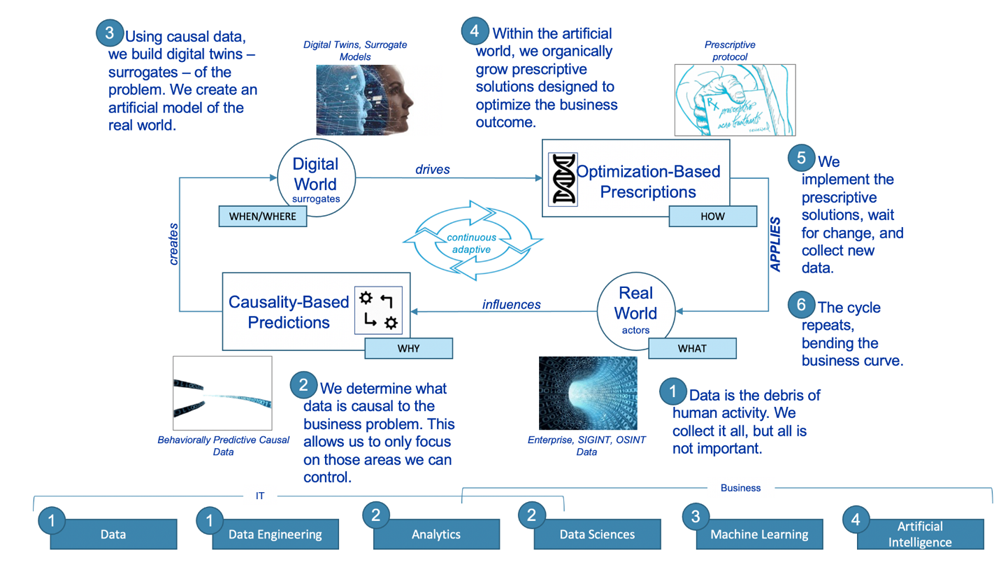6 min read
August 25, 2022


Dr. Jerry Smith
(Panelist), Managing Director, Global Analytics & Data Insights, AgileThought
1 Articles
Author's Articles

Dr. Jerry Smith
(Panelist), Managing Director, Global Analytics & Data Insights, AgileThought
1 Articles
AI
Business Value
Data
Decision Making
Many companies suffer from two constraints when it comes to effectively growing their business: Lack of resources and flawed decision-making. But when both are present, it can be an indication of an extinction-level event. It’s one thing to lack the resources to adequately lead and deliver tomorrow’s business value today, but when suboptimal decisions are being made across the enterprise at scale, that is a disaster.
The gaps between the complexity of the world and our problem-solving abilities are widening. With the explosion in data (know-your-customer, products, operations, support, marketing, interconnected things), no single person can keep up, even with the support of advanced analytics and reporting. Let’s test this. Right now – this very second – think about why a particular customer or prospect did not buy your product or service? You don’t know, but you should.
These decision-oriented challenges are limited by our human intelligence. But there is another way, a journey based on leveraging populations of smartness that scales on the backs of computers: Optimized Artificial Intelligence.
Change the World (and Your Market), Don’t Just Observe It
Optimized Artificial Intelligence identifies the ideal actions that maximize the business value of the surrogate models. It looks through all potential possibilities to find those activities that offer the best chance of achieving the desired objectives. Millions of simulations are constructed and evaluated in order to create an optimized set of actions; these are real executable activities that can change the behavior of people and generate new data that can be collected so that this evolutionary computing lifecycle can start all over again. Wash, rinse, and repeat.
Beyond Human Limitations of Decision-Making: How Your Business Can Impact Industry-Wide Shifts
Currently, AI is still based on a singular point of view or perspective; it doesn’t take into account other good ideas. It doesn’t know how to create new ideas out of other old ideas or a history of ideas. But the artificial intelligence (what to do about changes) value chain of the future will encompass data (material), data sciences (what we know about data), and machine learning (how will the data change in the future).
Optimized Artificial Intelligence is like having thousands, or even millions, of people brainstorming, prototyping, and testing ideas. It takes what works and builds out a new version, discarding those with subpar results. By doing so, it discovers possibilities that lie outside the knowledge of any single person or team of individuals. It is truly evolutionary. But not all evolutionary computation is implemented alike. Through years of experience, we’ve found there are three components driving business value through Optimized Artificial Intelligence: Causality, prediction, and prescription. All three operate in a loop; a natural continuous lifecycle within a business:
Causality
After we collect a whole lot of data, we need to really understand what is causal within that data. What are the problems? What is influencing engagement and a decision to buy? If data is the debris of human activity, then the goal is to extrapolate causal data to understand what impacts human behaviors that, in turn, affect business outcomes. And, the first part of that involves figuring out and then focusing on those behaviors (reflected in data) that drive true business value.
Prediction
Once we have that causal data, the real evolutionary magic happens. We organically create and evolve digital surrogates (simulations) that represent the business objective: Evolutionary neural networks. These surrogates think and act like their real-world counterparts – for example, your customers, employees, products or even a fraudster. We create these surrogates through transfer learning, the application of stored knowledge from one domain to the needs of another.
Prescription
Once a digital representation (surrogate) of how business value is generated, we can look for actions (inputs to the predictive surrogate model) that maximize value (surrogate outputs) and generate prescriptive solutions that will literally bend the business performance curve. These prescriptive actions are then transformed into solution characteristics, sales venues, and marketing programs.

Redefine Your Competitive Landscape
Businesses will increasingly turn to Optimized Artificial Intelligence to make better decisions. And when they do, they’ll make a quantum leap ahead of their peers because they’ll be using an advanced intelligence system to mitigate key limitations in human performance and scale — not to mention the unethical or biased use of AI. When that happens, it will signal a new evolution not only in AI, but in the way businesses make decisions.
Contact usWant to discuss your specific data sciences, machine learning, and artificial intelligence needs? Contact us today to have a discussion.
Share this content: